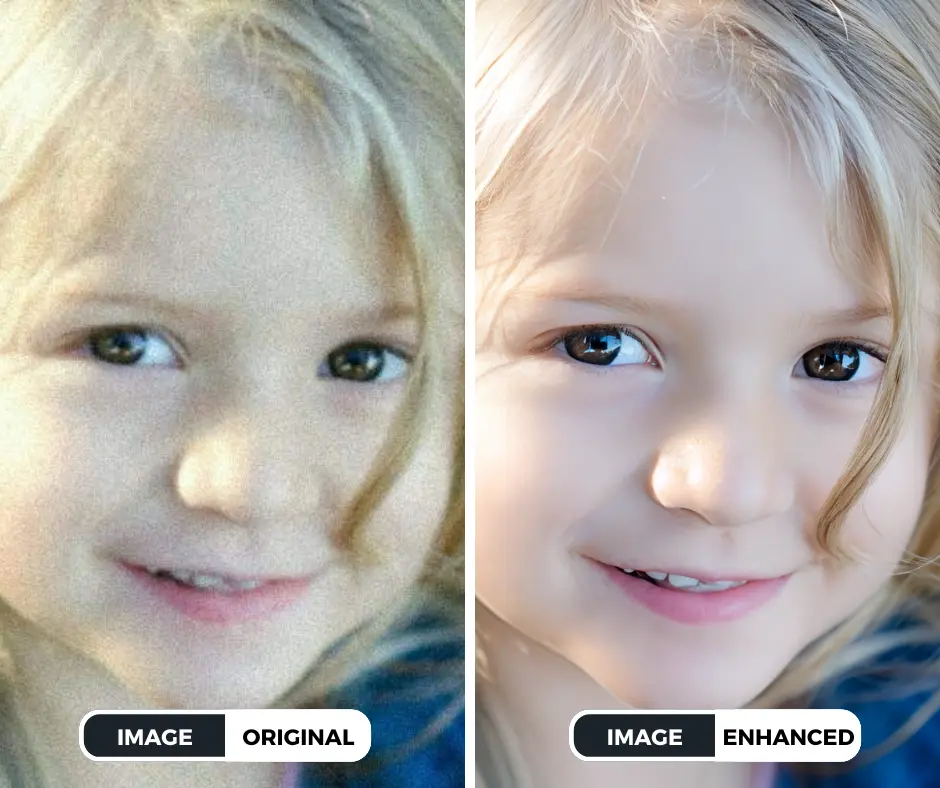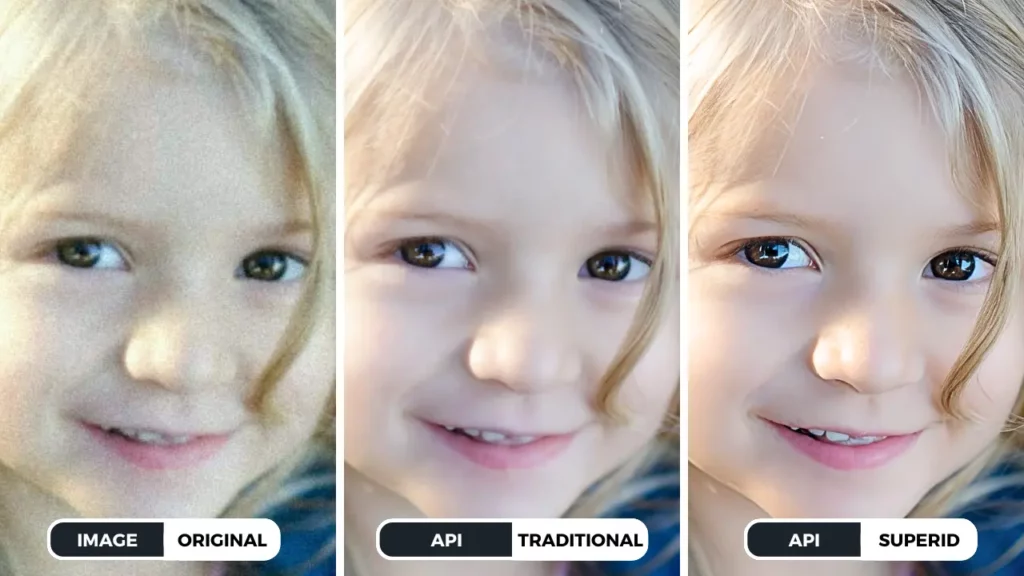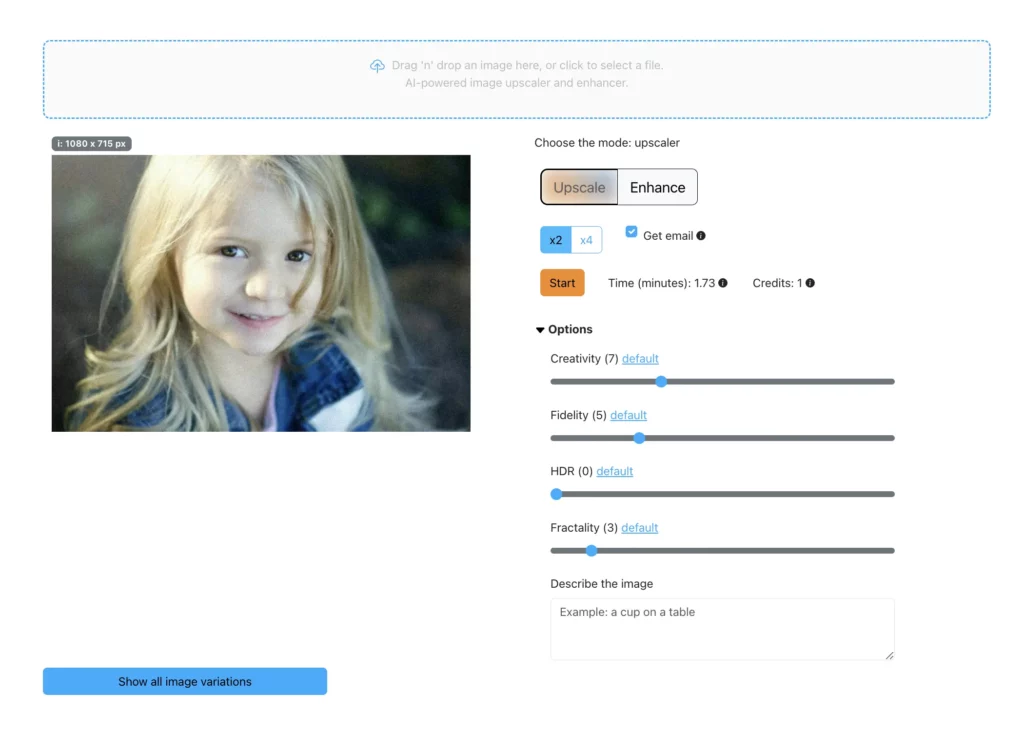Unabhängig von Größe, Format oder Auflösung können Ihre Bilder von einem Image Upscaler profitieren. Und Sie können schon heute mit einem KI-Tool eine effektive Hochskalierung für ein Bild vornehmen. SuperID bietet eine Image Upscaler API mit erstaunlichen Ergebnissen und Ressourcen. Im Folgenden finden Sie konkrete, umsetzbare Schritte, die Ihnen den Einstieg in die Image Upscaler API und deren Implementierung erleichtern.
Was ist eine Image Upscaler API?
Definition
Eine Bild-Upscaler-API ist eine Software-Schnittstelle, die es Entwicklern ermöglicht, die Qualität von Bildern durch Erhöhung ihrer Auflösung zu verbessern. Diese APIs nutzen fortschrittliche Algorithmen zur intelligenten Hochskalierung von Bildern, was zu einer schärferen, klareren und detaillierteren Darstellung führt.
Wie es funktioniert
Bild-Upscaler-APIs verwenden in der Regel Deep-Learning-Techniken, wie z. B. Faltungsneuronale Netze (CNN), um Bilder zu analysieren und zu verarbeiten. Diese Algorithmen werden auf riesigen Bilddatensätzen trainiert, sodass sie die komplexen Muster und Merkmale verschiedener visueller Inhalte lernen und verstehen können.
Wenn ein Bild in eine Bild-Upscaler-API hochgeladen wird, analysieren die KI-Algorithmen die Eigenschaften des Bildes und ermitteln Bereiche, die verbessert werden können. Die API wendet dann intelligente Techniken an, um die Auflösung zu erhöhen, während der ursprüngliche Inhalt und die Qualität des Bildes erhalten bleiben. Dabei werden neue Pixel generiert, die sich nahtlos in die vorhandenen Bilddaten einfügen, so dass eine detailliertere und visuell ansprechendere Ausgabe entsteht.

Vorteile der Verwendung einer Image Upscaler API
- Verbesserte Bildqualität: Bild-Upscaler-APIs können die Klarheit, Schärfe und Detailgenauigkeit von Bildern mit niedriger Auflösung erheblich verbessern. Dies ist besonders vorteilhaft für Anwendungen, bei denen die visuelle Qualität entscheidend ist, wie z. B. E-Commerce, Marketing und soziale Medien.
- Erhöhte Auflösung: Indem Sie die Auflösung von Bildern erhöhen, können Sie größere Versionen erstellen, die sich für den Druck, hochauflösende Displays oder andere Anwendungen eignen, die hochwertige Bilder erfordern.
- Verbesserte visuelle Anziehungskraft: Hochskalierte Bilder sehen oft visuell ansprechender und einnehmender aus, was die Aufmerksamkeit der Betrachter auf sich zieht und die allgemeine Benutzererfahrung verbessert.
- Zeit- und Kostenersparnis: Die Verwendung einer Bild-Upscaler-API kann Ihnen im Vergleich zu manuellen Bildbearbeitungstechniken Zeit und Mühe ersparen. Es kann auch kostengünstiger sein, als professionelle Fotografen zu engagieren oder hochauflösende Bilder zu kaufen.
Vorteile der Image Upscaler API
Verbesserte Bildqualität mit Image Upscaler APIs
Erhöhte Auflösung:
Einer der Hauptvorteile von Bild-Upscaler-APIs besteht darin, dass sie die Auflösung von Bildern mit geringer Auflösung deutlich erhöhen können. Dies bedeutet, dass Sie kleinere, weniger detaillierte Bilder nehmen und sie ohne Qualitätsverlust vergrößern können. Durch die Hinzufügung von mehr Pixeln können Bild-Upscaler-APIs mehr Details und Klarheit liefern, wodurch es einfacher wird, den Inhalt zu betrachten und zu schätzen.
Verbesserte Schärfe:
Bild-Upscaler-APIs können auch die Schärfe von Bildern verbessern. Durch die Verringerung von Unschärfe und die Schärfung von Kanten können diese APIs Bilder fokussierter und definierter erscheinen lassen. Dies ist besonders vorteilhaft für Bilder, die im Laufe der Zeit komprimiert oder verschlechtert wurden.
Erhöhte Klarheit:
Insgesamt können Bild-Upscaler-APIs die allgemeine Klarheit und Deutlichkeit von Bildern verbessern. Das bedeutet, dass der Inhalt des Bildes leichter zu sehen und zu verstehen ist. Unabhängig davon, ob Sie Text, Grafiken oder Fotos betrachten, können Bild-Upscaler-APIs dazu beitragen, den Inhalt lesbarer und visuell ansprechender zu machen.
Indem Sie die Leistung von Bild-Upscaler-APIs nutzen, können Sie die Qualität Ihrer Bilder verbessern und ein visuell ansprechendes Erlebnis für Ihr Publikum schaffen.
Gesteigerte visuelle Anziehungskraft
Verbesserte Ästhetik: Hochwertige Bilder, die durch Bild-Upscaler-APIs verbessert werden, können die Gesamtästhetik Ihrer Inhalte erheblich verbessern. Klare, scharfe und lebendige Bilder machen Ihre visuellen Inhalte für die Betrachter attraktiver und angenehmer.
Fesselnde Aufmerksamkeit: Optisch ansprechende Bilder können die Aufmerksamkeit Ihres Publikums sofort auf sich ziehen, so dass es eher geneigt ist, stehen zu bleiben und sich mit Ihren Inhalten zu beschäftigen. Dies ist besonders wichtig in der heutigen schnelllebigen digitalen Welt, in der die Aufmerksamkeitsspanne kurz ist.
Verbesserte Benutzerfreundlichkeit: Besser aussehende Bilder können das Gesamterlebnis der Nutzer auf Ihrer Website, Ihren Social-Media-Plattformen oder anderen digitalen Kanälen verbessern. Wenn Ihre Inhalte visuell ansprechend sind, ist die Wahrscheinlichkeit größer, dass die Nutzer bei der Sache bleiben und sich weiter informieren.
Professionelles Auftreten: Hochwertige Bilder können Ihren Inhalten ein professionelleres und ausgefeilteres Aussehen verleihen. Dies kann dazu beitragen, Glaubwürdigkeit zu schaffen und Vertrauen bei Ihrem Publikum aufzubauen. Wenn Sie in die Bildqualität investieren, können Sie ein Gefühl von Professionalität und Liebe zum Detail vermitteln.
Gesteigertes Engagement mit Image Upscaler APIs
Erhöhte Click-Through-Raten:
Wenn Ihre Bilder optisch ansprechend und qualitativ hochwertig sind, werden sie mit größerer Wahrscheinlichkeit die Aufmerksamkeit der Nutzer auf sich ziehen und sie zum Durchklicken animieren. Dies kann zu mehr Verkehr auf Ihrer Website oder Ihren Inhalten führen, was wiederum zu mehr Engagement und Konversionen führt.
Höhere Konversionsraten:
Eine bessere Bildqualität kann sich direkt auf die Konversionsraten auswirken. Ganz gleich, ob Sie Produkte online verkaufen, Leads generieren oder für eine Marke werben - visuell beeindruckende Bilder können einen großen Unterschied machen, wenn es darum geht, Nutzer zum Handeln zu bewegen.
Verbesserte Leistung in den sozialen Medien:
Hochwertige Bilder werden eher geteilt, geliked und auf Social-Media-Plattformen kommentiert. So können Ihre Inhalte ein größeres Publikum erreichen und die Sichtbarkeit Ihrer Marke erhöhen.
Zusammenfassend lässt sich sagen, dass Sie die Qualität Ihrer Bilder durch den Einsatz einer Image Upscaler API verbessern können:
- Erzielen Sie mehr Klicks und Besucher.
- Steigern Sie die Konversionsraten.
- Verbessern Sie die Leistung Ihrer sozialen Medien.
Letztlich kann eine Investition in die Bildqualität zu einem größeren Engagement, einer stärkeren Online-Präsenz und besseren Geschäftsergebnissen führen.
Kosteneffiziente Lösung: Image Upscaler APIs
Erschwingliche Bildverbesserung:
Einer der wesentlichen Vorteile der Verwendung von Bild-Upscaler-APIs besteht darin, dass sie eine kostengünstigere Lösung darstellen, als professionelle Fotografen zu engagieren oder hochauflösende Bilder zu kaufen. Durch den Einsatz von KI-Technologie können diese APIs die Qualität vorhandener Bilder verbessern und so die Notwendigkeit zusätzlicher Ausgaben verringern.
Skalierbarkeit:
Image Upscaler-APIs sind für die Verarbeitung großer Bildmengen ausgelegt und eignen sich daher für Unternehmen und Einzelpersonen mit hohem Bildverarbeitungsbedarf. Unabhängig davon, ob Sie eine kleine Anzahl von Bildern oder Tausende von Bildern zu verarbeiten haben, können diese APIs diese ohne Qualitätseinbußen effizient verbessern.
Zeitersparnis:
Bild-Upscaler-APIs können den Prozess der Bildverbesserung automatisieren und Ihnen so Zeit und Mühe ersparen. Anstatt jedes Bild manuell zu bearbeiten, können Sie es einfach in die API hochladen und die Arbeit erledigen lassen. So haben Sie mehr Zeit, sich auf andere Aspekte Ihres Unternehmens oder Ihrer kreativen Projekte zu konzentrieren.
Durch den Einsatz einer Bild-Upscaler-API können Sie die Qualität und Wirkung Ihrer visuellen Inhalte erheblich verbessern und gleichzeitig Zeit und Geld sparen. Egal, ob Sie ein professioneller Fotograf, ein Geschäftsinhaber oder einfach jemand sind, der seine Bilder verbessern möchte - Bild-Upscaler-APIs bieten eine wertvolle und kostengünstige Lösung.
Implementierung der Image Upscaler API

Die Auswahl der richtigen API:
Erschwingliche Bildverbesserung:
Einer der wesentlichen Vorteile der Verwendung von Bild-Upscaler-APIs besteht darin, dass sie eine kostengünstigere Lösung darstellen, als professionelle Fotografen zu engagieren oder hochauflösende Bilder zu kaufen. Durch den Einsatz von KI-Technologie können diese APIs die Qualität vorhandener Bilder verbessern und so die Notwendigkeit zusätzlicher Ausgaben verringern.
Skalierbarkeit:
Image Upscaler-APIs sind für die Verarbeitung großer Bildmengen ausgelegt und eignen sich daher für Unternehmen und Einzelpersonen mit hohem Bildverarbeitungsbedarf. Unabhängig davon, ob Sie eine kleine Anzahl von Bildern oder Tausende von Bildern zu verarbeiten haben, können diese APIs diese ohne Qualitätseinbußen effizient verbessern.
Zeitersparnis:
Bild-Upscaler-APIs können den Prozess der Bildverbesserung automatisieren und Ihnen so Zeit und Mühe ersparen. Anstatt jedes Bild manuell zu bearbeiten, können Sie es einfach in die API hochladen und die Arbeit erledigen lassen. So haben Sie mehr Zeit, sich auf andere Aspekte Ihres Unternehmens oder Ihrer kreativen Projekte zu konzentrieren.
Durch den Einsatz einer Bild-Upscaler-API können Sie die Qualität und Wirkung Ihrer visuellen Inhalte erheblich verbessern und gleichzeitig Zeit und Geld sparen. Egal, ob Sie ein professioneller Fotograf, ein Geschäftsinhaber oder einfach jemand sind, der seine Bilder verbessern möchte - Bild-Upscaler-APIs bieten eine wertvolle und kostengünstige Lösung.
Implementierung der Image Upscaler API
Die Auswahl der richtigen API:
Die Auswahl der besten Bild-Upscaler-API hängt von Ihren spezifischen Bedürfnissen und Anforderungen ab. Hier erfahren Sie, wie Sie die perfekte Lösung finden:
Berücksichtigen Sie Ihre Bedürfnisse: Die Wahl der richtigen Image Upscaler API
Bei der Auswahl einer Bild-Upscaler-API ist es entscheidend, Ihre spezifischen Anforderungen zu bewerten und die für Sie wichtigsten Faktoren zu priorisieren. Hier sind einige wichtige Überlegungen:
1. Berücksichtigen Sie Ihre Bedürfnisse:
Bildqualität:
- High-Resolution Output: Suchen Sie nach APIs, die hochauflösende Bilder mit minimalen Artefakten oder Rauschen erzeugen können.
- Bewahrung von Details: Stellen Sie sicher, dass die API feine Details und Texturen in den hochskalierten Bildern beibehalten kann.
- Natürliches Erscheinungsbild: Die hochskalierten Bilder sollten natürlich aussehen und nicht zu künstlich oder pixelig wirken.
Benutzerfreundlichkeit:
- Benutzerfreundliches Interface: Ziehen Sie APIs mit intuitiven Schnittstellen in Betracht, die leicht zu navigieren und zu verstehen sind.
- Klare Dokumentation: Eine gute Dokumentation hilft Ihnen bei der Integration der API in Ihre Anwendungen und bei der Behebung von Problemen.
Skalierbarkeit:
- Handhabung großer Volumina: Wenn Sie eine große Anzahl von Bildern hochskalieren wollen, sollten Sie eine API wählen, die Ihre Arbeitslast effizient bewältigen kann.
- Leistung: Berücksichtigen Sie die Leistung der API bei hoher Belastung, um sicherzustellen, dass sie rechtzeitig Ergebnisse liefern kann.
Preisgestaltung:
- Kosten-Nutzen-Verhältnis: Vergleichen Sie die von verschiedenen APIs angebotenen Preismodelle, um ein für Ihr Budget geeignetes zu finden.
- Merkmale: Prüfen Sie die in jeder Preisstufe enthaltenen Funktionen, um sicherzustellen, dass Sie ein gutes Preis-Leistungs-Verhältnis erhalten.
Wenn Sie diese Faktoren sorgfältig berücksichtigen, können Sie eine Bild-Upscaler-API auswählen, die Ihren spezifischen Anforderungen entspricht und die gewünschten Ergebnisse liefert.
2. Warum SuperIDs Image Upscaler API sich abhebt:
Überlegene Qualität:
- Fortgeschrittene Algorithmen: SuperID nutzt hochmoderne KI-Algorithmen, um außergewöhnliche Ergebnisse beim Hochskalieren von Bildern zu erzielen.
- Detailaufbewahrung: Die API bewahrt komplizierte Details und Texturen und sorgt dafür, dass Bilder auch nach der Hochskalierung ihren ursprünglichen Charakter behalten.
- Natürlich aussehende Ergebnisse: Die Algorithmen von SuperID werden auf einem umfangreichen Datensatz von Bildern trainiert, so dass sie Ergebnisse liefern, die natürlich und realistisch wirken.
Nahtlose Integration:
- Einfache Integration: Die API von SuperID wurde für die mühelose Integration in Ihre bestehenden Systeme entwickelt, unabhängig davon, ob Sie eine Webanwendung, eine mobile App oder eine Desktop-Software entwickeln.
- Flexibilität: Die API bietet Flexibilität bei der Nutzung, so dass Sie den Upscaling-Prozess an Ihre spezifischen Anforderungen anpassen können.
Skalierbarkeit und Verlässlichkeit:
- Leistungsstarke Infrastruktur: Die Infrastruktur von SuperID ist darauf ausgelegt, große Mengen an Bildverarbeitung zu bewältigen und auch bei hoher Belastung eine zuverlässige Leistung zu gewährleisten.
- Skalierbarkeit: Die API lässt sich skalieren, um Ihren wachsenden Anforderungen gerecht zu werden, so dass Sie mehr Bilder verarbeiten können, wenn Ihr Unternehmen expandiert.
Benutzerfreundlich:
- Gut dokumentierte API: SuperID bietet eine umfassende Dokumentation und Tutorials, um Ihnen den Einstieg zu erleichtern und das Beste aus der API zu machen.
- Intuitive Schnittstelle: Die Schnittstelle der API ist benutzerfreundlich gestaltet, so dass sie auch von Personen mit begrenzten technischen Kenntnissen leicht genutzt werden kann.
Wenn Sie sich für die Image Upscaler API von SuperID entscheiden, profitieren Sie von einer überragenden Bildqualität, nahtloser Integration, Skalierbarkeit und einer benutzerfreundlichen Anwendung.
3. Erkunden Sie SuperIDs Image Upscaler API im Detail:
Einen tieferen Einblick in die Funktionen, Preise und Tutorials der Image Upscaler API von SuperID finden Sie auf deren Website: https://piktid.com/ai-api/.

API-Integration:
Die Integration einer Image Upscaler API in Ihre Website oder Anwendung umfasst mehrere Schritte:
- Registrieren Sie sich und erhalten Sie API-Zugangsdaten: Erstellen Sie ein Konto auf der Plattform des API-Anbieters und erhalten Sie Ihren eindeutigen API-Schlüssel oder Ihr Zugriffstoken.
- Wählen Sie eine Programmiersprache: Wählen Sie die Programmiersprache, die Sie für die Integration verwenden möchten (z. B. Python, Javascript usw.). Die meisten APIs bieten Codeschnipsel und Bibliotheken für verschiedene Sprachen.
- Entwickeln Sie den Integrationscode: Schreiben Sie Code für die Interaktion mit der API unter Verwendung Ihrer Anmeldeinformationen und senden Sie Bilddaten für die Hochskalierung.
- Bildbearbeitung implementieren: Entwickeln Sie Funktionen zum Abrufen und Senden von Bildern zur Verarbeitung in Ihrer Anwendung.
- Handle Response: Verarbeiten Sie die Antwort der API, die in der Regel das hochskalierte Bild und relevante Informationen enthält.
API-Verwendung:
Die API-Dokumentation von SuperID (https://api.piktid.com/docs#/) enthält detaillierte Anweisungen zur Verwendung der API für die Hochskalierung von Bildern. Hier sind einige allgemeine Konzepte:
- API-Endpunkt: Dies bezieht sich auf die spezifische URL, die Sie für den Zugriff auf die Upscaling-Funktionalität aufrufen.
- Bild hochladen: Die API akzeptiert normalerweise Bilddaten in verschiedenen Formaten wie JPEG, PNG usw.
- Parameter und Optionen: Möglicherweise können Sie Parameter wie den gewünschten Hochskalierungsfaktor, das Ausgabeformat und den Komprimierungsgrad angeben.

Bewährte Praktiken:
- Beginnen Sie mit niedriger Auflösung: Testen Sie die API zunächst mit niedrig aufgelösten Bildern, um Qualität und Leistung zu beurteilen.
- Optimieren Sie die Bildkomprimierung: Das Hochskalieren von komprimierten Bildern kann Artefakte verstärken. Verwenden Sie nach Möglichkeit verlustfreie Komprimierungsformate.
- Überwachen Sie Nutzung und Kosten: Verfolgen Sie Ihre API-Nutzung, um Grenzwertüberschreitungen zu vermeiden und die damit verbundenen Kosten zu verwalten.
- Fehlerbehandlung: Implementieren Sie Code zur Behandlung potenzieller Fehler, die von der API zurückgegeben werden, z. B. ungültige Bildformate oder Überschreitung der zulässigen Nutzungsgrenzen.
Fehlersuche:
Hier sind einige häufige Probleme und ihre Lösungen:
- API-Fehler: Fehlercodes und Anleitungen zur Fehlerbehebung finden Sie in der API-Dokumentation.
- Schlechte Upscaling-Qualität: Passen Sie API-Parameter wie den Hochskalierungsfaktor an oder probieren Sie verschiedene Bildformate aus.
- Fragen der Integration: Überprüfen Sie Ihren Code noch einmal und stellen Sie sicher, dass die richtigen Authentifizierungsdaten verwendet werden.
- Performance-Probleme: Erwägen Sie API-Drosselungsgrenzen oder ein Upgrade Ihres Tarifs für höhere Verarbeitungsgeschwindigkeiten.
Wenn Sie diese Richtlinien befolgen und die leistungsstarke Image Upscaler API von SuperID nutzen, können Sie nahtlos Bild-Upscaling-Funktionen in Ihre Anwendungen integrieren und das Potenzial von qualitativ hochwertigen Bildern erschließen.
Nutzen Sie Image Upscaler API für Fotografen, um Ihren Erfolg weiter zu steigern
Verbesserter Arbeitsablauf:
- Zeitersparnis: Bild-Upscaler-APIs können die Zeit, die Fotografen mit der Bearbeitung niedrig aufgelöster Bilder verbringen, erheblich reduzieren. So können sie sich mehr auf die Aufnahme neuer Bilder und die Verbesserung ihres gesamten Arbeitsablaufs konzentrieren.
- Effizienz: Durch die Automatisierung des Prozesses zur Verbesserung der Bildqualität können Fotografen ihren Produktionsprozess rationalisieren und ihre Effizienz steigern.
- Konsistenz: Die Verwendung einer Bild-Upscaler-API kann dazu beitragen, eine einheitliche Qualität für das gesamte Portfolio eines Fotografen zu gewährleisten.
Erweitertes Portfolio:
- Visuelle Anziehungskraft: Qualitativ hochwertige Bilder können das Portfolio eines Fotografen für potenzielle Kunden optisch ansprechender und interessanter machen.
- Professionalität: Die Verwendung einer Bild-Upscaler-API zeugt von einem hohen Anspruch an Qualität und Professionalität.
- Glaubwürdigkeit: Ein Portfolio mit qualitativ hochwertigen Bildern kann dazu beitragen, die Glaubwürdigkeit und Kompetenz eines Fotografen zu belegen.
Erfolg in den sozialen Medien:
- Erhöhtes Engagement: Optisch ansprechende Bilder erregen mehr Aufmerksamkeit und Engagement auf den Plattformen der sozialen Medien.
- Größere Anhängerschaft: Ein kontinuierlicher Strom hochwertiger Inhalte kann Fotografen helfen, ihre Anhängerschaft zu vergrößern und ein größeres Publikum zu erreichen.
- Markenbekanntheit: Die Verwendung von Bild-Upscaler-APIs zur Erstellung visuell beeindruckender Inhalte kann Fotografen dabei helfen, Markenbewusstsein und Wiedererkennungswert aufzubauen.
Monetarisierungsmöglichkeiten:
- Verkauf von Stockfotos: Qualitativ hochwertige Bilder sind bei Unternehmen und Privatpersonen auf der Suche nach Stockfotos gefragt. Fotografen können ihre Bilder über Stockfoto-Plattformen verkaufen.
- Digitale Produkte: Fotografen können mit ihren bearbeiteten Bildern digitale Produkte wie Fotoabzüge, Kalender oder digitale Kunstwerke erstellen und verkaufen.
- Kundenprojekte: Hochwertige Bilder können mehr Kunden anziehen und zu besser bezahlten Projekten führen.
Durch die Nutzung von Bild-Upscaler-APIs können Fotografen ihre Arbeitsabläufe verbessern, ihre Portfolios aufwerten, in den sozialen Medien erfolgreich sein und neue Monetarisierungsmöglichkeiten erschließen.
Verbessern Sie Ihre Bilder mit der Image Upscaler API von SuperID
In diesem Blogbeitrag haben wir die transformative Kraft von Bild-Upscaler-APIs untersucht. Wir haben erörtert, wie diese KI-gestützten Tools die Bildqualität, die Auflösung und die allgemeine visuelle Attraktivität erheblich verbessern können. Wir haben die zahlreichen Vorteile der Verwendung von Bild-Upscaler-APIs hervorgehoben, darunter:
- Verbesserte Bildqualität: Hochskalieren Sie Bilder mit niedriger Auflösung und erzielen Sie eine beeindruckende Klarheit, Detailgenauigkeit und Schärfe.
- Gesteigerte visuelle Anziehungskraft: Erstellen Sie visuell fesselnde Bilder, die Ihre Website, Ihre Präsenz in sozialen Medien und andere Marketingmaterialien aufwerten.
- Verstärktes Engagement: Ziehen Sie die Aufmerksamkeit des Publikums mit fesselnden Bildern auf sich und halten Sie sie aufrecht.
- Kosteneffiziente Lösung: Hochwertige Bilder ohne die Kosten für die Anstellung professioneller Fotografen oder den Kauf von Stockfotos.
Nutzen Sie die Image Upscaler API von SuperID:
Wir haben speziell die Image Upscaler API von SuperID als führend in diesem Bereich erwähnt. SuperID bietet eine robuste und benutzerfreundliche API, die außergewöhnliche Ergebnisse liefert. Mit SuperID können Sie:
- Hochwertiges Upscaling erreichen: Erleben Sie die hochmoderne KI-Technologie, die eine hervorragende Bildqualität und Detailgenauigkeit gewährleistet.
- Nahtlose Integration: Integrieren Sie die API einfach in Ihre bestehenden Arbeitsabläufe, um einen reibungslosen Ablauf zu gewährleisten.
- Skalierbare Lösung: Die API von SuperID lässt sich mühelos skalieren, um Ihre wachsenden Anforderungen an die Bildverarbeitung zu erfüllen.
Sind Sie bereit, die Macht der hochwertigen Bilder zu nutzen? Besuchen Sie die Website von Piktid um mehr über SuperIDs Image Upscaler API und seine Möglichkeiten zu erfahren. Zögern Sie nicht, die detaillierte API-Dokumentation zu lesen (https://piktid.com/ai-api/) für eine schrittweise Anleitung zur Implementierung der leistungsstarken Lösung von SuperID.
Laden Sie Ihre Bilder mit SuperID auf und erzeugen Sie einen bleibenden Eindruck bei Ihrem Publikum.

